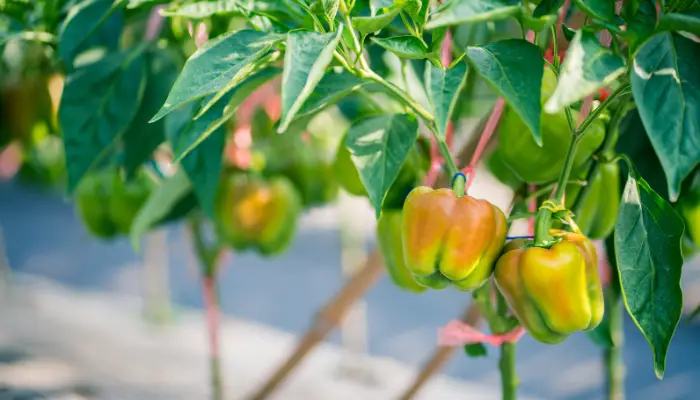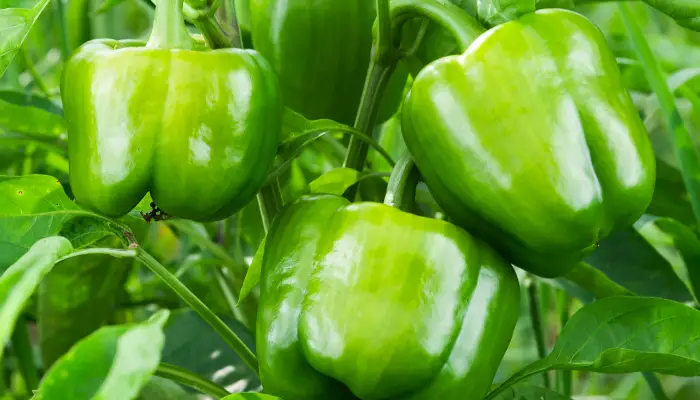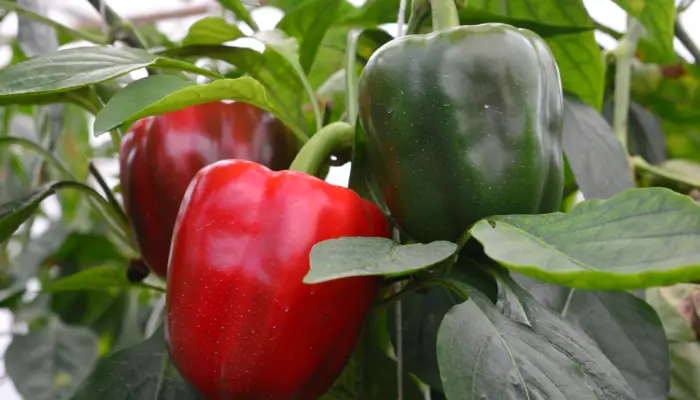While peppers can exhibit a wide range of colors, one of the most fascinating phenomena is the turning of green peppers into red.
Although green peppers are frequently found in gardens and grocery stores, their transformation into a striking red hue begs the question,
“Why do green peppers turn red?” In this blog post, we will explore the fascinating biology behind this colorful metamorphosis.
The Anatomy of Peppers
Peppers belong to the genus Capsicum and are part of the Solanaceae family, which also includes tomatoes, potatoes, and eggplants. The color-changing magic happens in the pepper’s outer layer, specifically in the fruit’s skin.
Why Do Green Peppers Turn Red?

Green peppers undergo a fascinating transformation to achieve their vibrant red hue, a process deeply rooted in their biological and physiological makeup.
At the heart of this color metamorphosis are pigments, specifically chlorophyll and carotenoids.
In their early stages, green peppers derive their color from chlorophyll, the pigment responsible for photosynthesis.
As the peppers ripen, the production of chlorophyll decreases, unveiling the presence of carotenoids, particularly beta-carotene and capsanthin.
These carotenoids, previously masked by the dominant green chlorophyll, become more pronounced, resulting in the shift from green to red.
The ripening process involves intricate biochemical changes facilitated by the plant hormone ethylene, which acts as a signaling molecule triggering alterations in color and texture.
Environmental factors, including temperature, light, and humidity, further influence the ripening timeline and intensity.
Genetic variability among pepper varieties contributes to differences in the speed and pattern of color change, showcasing the intricate dance between nature and genetics.
The importance of this transformation extends beyond aesthetics, impacting the flavor profile and nutritional content of the peppers.
Ripe red peppers, with their enhanced sweetness and increased levels of vitamin C and antioxidants, not only add a burst of color to dishes but also offer a flavorful and nutritious culinary experience.
Overall, the journey from green to red in peppers is a captivating blend of genetics, biochemistry, and environmental influence, highlighting the marvels of nature’s intricate processes.
Chlorophyll and Carotenoids
The color of a pepper is determined by its pigments, and two main groups play a significant role in this process: chlorophyll and carotenoids.
Green peppers owe their color to chlorophyll, the pigment responsible for photosynthesis in plants.
As peppers ripen, chlorophyll production decreases, revealing the presence of carotenoids.
Carotenoids are the pigments responsible for the red, orange, and yellow hues in many fruits and vegetables.
In green peppers, a specific carotenoid called beta-carotene is present but masked by the dominant green chlorophyll. As the pepper matures, the concentration of carotenoids increases, leading to the transformation from green to red.
The Ripening Process

The journey from green to red is essentially a ripening process.
Peppers, like many fruits, undergo a series of biochemical changes as they mature.
One key factor influencing this transformation is the production of ethylene, a natural plant hormone.
Ethylene acts as a signaling molecule, triggering various physiological responses in the fruit, including changes in color and texture.
During ripening, enzymes within the pepper break down chlorophyll molecules, causing the green color to fade.
Simultaneously, the concentration of carotenoids, particularly beta-carotene and capsanthin, increases.
Capsanthin is the primary carotenoid responsible for the red color in peppers, and its abundance gives ripe peppers their vibrant red hue.
Environmental Factors
While the biological process of ripening is intrinsic to peppers, environmental factors can influence the timing and intensity of the color change.
Temperature, light, and humidity play crucial roles in the ripening process.
Warmer temperatures generally accelerate ripening, while exposure to sunlight can enhance the development of red pigments.
Conversely, factors such as high humidity and excessive rainfall can impact the ripening process negatively.
Excessive moisture can lead to diseases that affect the pepper’s overall health and compromise the ripening timeline.
Therefore, the interplay between genetics and environmental conditions determines the rate and success of a pepper’s transformation from green to red.
Genetic Variability
Not all peppers follow the same color-changing timeline.
Genetic variability among pepper varieties results in differences in ripening patterns. Some peppers may transition quickly from green to red, while others may undergo a more gradual change.
This genetic diversity is why you might find peppers of varying colors and flavors within the same species.
The Importance of Ripening
Ripening is a crucial phase in a pepper’s life cycle, marking the transition from an immature, often bitter fruit to a mature, sweet, and flavorful one.
As peppers ripen and undergo these color changes, their nutritional composition also evolves.
Ripe red peppers typically have higher levels of certain nutrients, including vitamin C and antioxidants, compared to their green counterparts.
Beyond the culinary appeal, the ripening process also plays a role in seed dispersal.
When a pepper reaches maturity, it signals to potential seed dispersers, such as birds, that its seeds are ready for consumption.
The vibrant red color serves as a visual cue, attracting animals that play a vital role in the pepper plant’s reproductive cycle by consuming the fruit and dispersing the seeds.
Culinary Applications:
Understanding the science behind why green peppers turn red has practical implications in the kitchen. The flavor profile of a pepper evolves as it ripens, with red peppers generally exhibiting a sweeter taste compared to their green counterparts. This difference in flavor makes red peppers a popular choice for roasting, grilling, or adding a burst of sweetness to salads and dishes.
In addition to their enhanced sweetness, red peppers boast higher levels of certain nutrients.
The increased concentration of vitamin C and antioxidants in red peppers makes them not only a flavorful addition to meals but also a nutritious one. Incorporating a variety of pepper colors into your diet ensures a diverse range of nutrients and flavors.
Conclusion
The transformation of green peppers into the vibrant red gems we often see in grocery stores is a fascinating journey rooted in the intricate interplay of pigments, enzymes, and environmental factors.
From the initial dominance of chlorophyll to the emergence of carotenoids, the ripening process turns a seemingly ordinary green pepper into a flavorful and nutritious red delight.
Frequently Asked Questions (FAQs) and Their Answers
Q1: What is the purpose of green peppers turning red?
A1: The transformation from green to red in peppers is part of the ripening process. As peppers mature, chlorophyll production decreases, revealing the presence of carotenoids like capsanthin, which gives the red color. This ripening process not only affects the visual appeal of the pepper but also influences its flavor and nutritional composition.
Q2: Do all green peppers turn red?
A2: No, not all green peppers turn red. The transformation is influenced by various factors, including genetics, environmental conditions, and the specific pepper variety. While many peppers, such as bell peppers, can turn red as they ripen, some varieties may mature to different colors, like yellow or orange.
Q3: What environmental factors influence the color change in peppers?
A3: Temperature, light, and humidity are key environmental factors that can impact the ripening process in peppers. Warmer temperatures generally accelerate ripening, exposure to sunlight can enhance the development of red pigments, while excessive humidity or rainfall can negatively affect the process.
Q4: Are red peppers more nutritious than green peppers?
A4: Yes, in general, red peppers tend to be more nutritious than green peppers. As peppers ripen, their nutritional composition changes. Red peppers often have higher levels of vitamin C and antioxidants compared to their green counterparts. The color change signifies an increase in certain nutrients, making ripe red peppers a flavorful and nutritious choice.
Q5: Can you eat green peppers, or do they have to turn red first?
A5: Yes, green peppers are entirely edible, and many people enjoy them in various dishes. However, the flavor profile of green peppers differs from that of red peppers. Green peppers are typically less sweet and slightly more bitter than their ripe, red counterparts. Culinary preferences may vary, and both green and red peppers have their own unique uses in the kitchen.
Q6: How long does it take for a green pepper to turn red?
A6: The time it takes for a green pepper to turn red can vary based on factors such as the specific pepper variety, environmental conditions, and temperature. On average, it may take a few weeks for a green pepper to undergo the ripening process and transition to a red color.
Q7: Can you speed up the ripening process of green peppers?
A7: Yes, several methods can potentially speed up the ripening process of green peppers. Placing them in a paper bag with a ripe banana or apple, which releases ethylene gas, can hasten ripening. Additionally, storing peppers in a warm and sunny location can accelerate the color change.

